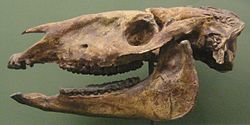Parahippus
| Parahippus Temporal range: Early Miocene
| |
|---|---|

| |
| Parahippus cognatus | |
| Scientific classification | |
| Kingdom: | |
| Phylum: | |
| Class: | |
| Order: | |
| Family: | |
| Subfamily: | |
| Genus: | Parahippus
|
Parahippus is an extinct relative of the modern horse, very similar to Miohippus, but slightly larger, at around 1 metre (9.3 hands)*.
About 20 million years ago, during the Miocene Period, the Earth was drastically changing: great plains were developing, forests were thinning out, mountains were forming, and swamps were drying up. [citation needed] It is believed these developments affected many changes in the existing horse ancestors.
Description
Parahippus was larger than Miohippus, with longer legs and face. The bones in the legs were fused and this, along with muscle development, allowed Parahippus to move with forward-and-back strides. Flexible leg rotation was eliminated, so that the animal was better adapted to fast forward running on open ground without moving from side to side. Most importantly, Parahippus was able to stand on its middle toe, instead of walking on pads, which gave it the ability to run faster; its weight was supported by ligaments under the fetlock to the big central toe. The side toes were almost vestigial, and seldom touched the ground.[citation needed]
Since leafy food had become scarce, these animals were forced to subsist on the newly-evolved grasses that were by now taking over the plains, and their teeth adapted accordingly. The extra molar crest that was variable in Miohippus became permanent in Parahippus. The molars developed high crowns and a hard covering for grinding the grass, which was typically covered with high-silica dust and sand.[1]
See also
References
- ^ Palmer, D., ed. (1999). The Marshall Illustrated Encyclopedia of Dinosaurs and Prehistoric Animals. London: Marshall Editions. p. 256. ISBN 1-84028-152-9.
